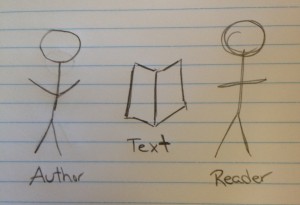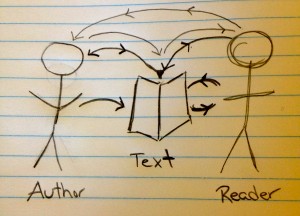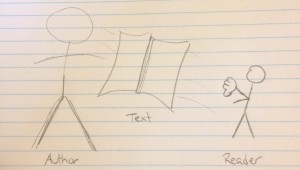As someone who thinks of himself as a fast walker, I’ve noticed a definite slowing of my pace since I arrived at The Lawrenceville School for the Klingenstein Summer Institute. Every conversation, discussion, lecture, or reading has weighed heavily on me between sessions. To acknowledge Dr. Pearl Rock Kane’s opening address, I have been complicated. This sends me on wild spirals of self-doubt and despair, but also brings me great moments of affirmation. Overall, I think it balances out into that much-needed sense of discomfort that propels me to be better.
A fairly simple, yet incredibly insightful tool was tabled today by Liz Perry and Eder J. Williams McKnight, the English lead teachers. It simply involved the following drawing: 
Using any amount of manipulation we wanted, we were then asked to try and represent the relationship between the author, the text, and ourselves as the reader. My personal model initially came out like this:

Crude drawing aside, I wanted to capture the following points:
- The relationship between the reader and the text is ongoing and the reader has to keep constructing meaning within that relationship.
- The author created the text and must be humanized and involved, to some extent, in the understanding of that text.
- We can understand the author, to some extent, through the text and then use that understanding to inform our understanding of the text.
- We can understand the author, to some extent, outside of the text (research, etc.) and then use that information to inform our understanding of the text.
Feeling like I had done a good job accurately portraying my understanding within the model provided, it was so great to see the different models put forward by my colleagues. One went very meta and added in so many other possible manipulators on the text, including cultural, historical, and linguistic factors as well as institutional factors such as publishers, translators, and academia. Another wanted to ensure the larger community of readers was included in the diagram.
Already, diverse thinking about these relationships had been made visible. Next we were challenged to discuss how we thought that relationship would change if we drew from the perspective of a student. While it didn’t involve the same sharing of pictures, it did involve some amazing insights that translate into powerful take-aways. I’ve tried to recreate some of these relationships in images.
(Above) Liz Perry stated that she often saw her students trying to grapple with the idea of an author as larger than life and somehow the text was coming at them like this giant, incredible force and it was their job to try and catch it and absorb that huge impact.
(Below) Other teachers saw students as believing that they needed the passion and insight of their teacher in order to effectively access the text. 
(Below) Still other teachers saw students as trying to remove the actual engagement with the text from the equation. Instead, students utilized summaries and opinions to try and “get” the text without having to construct any textual meaning for themselves. 
From my perspective, I see different students in each of the models presented. The importance of this exercise is not to think we now know how our students think, but to point out that there are so many different ways to envision the relationship between author, text, and reader. Even amongst the expert readers in my curriculum group, there existed incredible diversity and varying theoretical lenses. The important first step is making those lenses clear to ourselves – to make our own thinking visible. I am excited to go through this exercise with my students to help them uncover their own thinking. This is where we can spot misconceptions and better prepare our readers to see that reading is an act of authorship and that students are not just passively receiving the text, but trying to position themselves in relationship to the text. Meaning is not revealed to students, but constructed by them.


Hey Aaron,
Thanks for sharing. I love the idea of using drawings to help us process ideas and information. Like you, I’ve found myself swimming in ideas and notes on google docs and links on diigo and books added to goodreads. Blogging to process all of the information has been helpful, but you just reminded me that I brought a sketchbook and perhaps I should spend my break tomorrow sitting in the shade drawing. Thanks for the reminder that there are many ways to process information!
Leslie
It’s something I often forget too, despite it being such an authentic way for some students to make their thinking visible. Thoughts so rarely stay on lines and between margins. Thanks for commenting!
Aaron and Leslie,
Just a comment/note to say thanks! Reading all of your blog posts from afar is an enlivening and enriching experience to say the least. Aaron, to borrow a phrase from your recent Cohort 21 blog post, you indeed have an “audience” and we are listening! You two and the others at #KSI14/Cohort 21 are helping to reshape how PD in the independant schools is done. KSI continues to be an essential phase for up and coming teachers, but I wonder how well those KSI lessons were shared in pre-edtech days? I, for one, know many KSI teachers, but not much about KSI. As a teacher that is just outside of the KSI catchment (first 5 years), I am very appreciative of the day by day sharing you are doing. This sort of reflection undoubtedly improves your own process of learning while down there, but it also improves that of your audience. And I have no doubt this will come back to you in spades in the future… Your reflections allow the casual observer to engaged meaningfully on your journey and to suppliment/augment our own jourenys. Having just finsihed a two day PD session myself, I pushed the presenters with questions and contributions to get more out of PD based on what I had learned from Leslie’s posts. I think this speaks volumes to how collaboration and professional development is happening today; it is evermore personalized, accessible in the end MEANINGFUL (you better believe I CAPITALIZED that!). The only question I’m left with is how I can repay you two!
All the best with KSI14 and keep doing what your doing!
Thank you so much for your kind words, Charles. As someone relatively new to blogging, it certainly was something I had to work on, but the way it forces you to engage and construct meaning for yourself has made all of my professional reading, musings and PD sessions more valuable. A lot of the power of KSI and Cohort 21 comes from simply having a venue to communicate and lots of great edtech (Blogspot, Twitter, etc.) is built around creating new opportunities to build giant venues of communication. Thank you so much for helping to make it into a conversation rather than just a simple, yet powerful, sounding board.